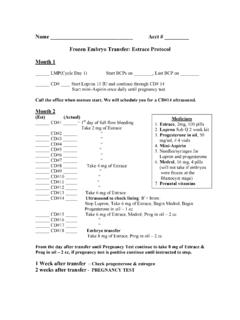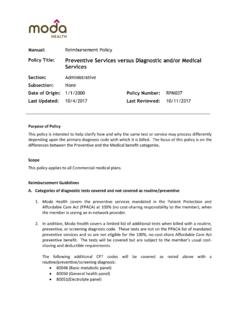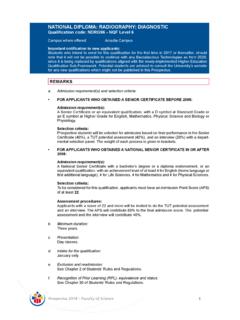Transcription of IVF Patient Information copy
1 1 IVF Patient Information Family Beginnings, PC 8435 Clearvista Pl. Suite 104 Indianapolis, IN 46256 317-595-3665 Overview: 1. Basic timeline for IVF. 2. Preliminary testing. 3. Medications. 4. Procedures and what to expect. 5. Sample Protocols; IVF Long Lupron Protocol with BCPs (PDF file) IVF Micro Lupron Protocol with BCPs (PDF File) 1. Basic timeline for IVF. Many patients have had a physical, emotional and financial journey by the time they consider IVF as a treatment. OB/GYNs may have performed surgeries or done ovulation induction with clomid for many months that seem to drag on. The feeling of loss of control is very real for many patients . When patients get to IVF, things seem a bit more regimented and hopefully some sense of control is restored. Generally we will get eggs and know they fertilize and embryos grow, something we do not know when clomid fails.
2 When the menstrual cycle starts in month #1, we fill in the dates on one of the protocols listed above. Most patients will fall within a day or two of the predicted dates. We like to consider IVF as a two-month process. During the 1st month ovarian reserve testing may be done along with an assessment of the uterine cavity. A semen analysis will be done and a semen sample cryopreserved as a back-up in case the male can not provide a sample the day of the egg retrieval. The IVF lab needs a more recent assessment of the sperm that will be used the following month. Many patients will be placed on oral contraceptives in order to reduce the chance of cyst formation secondary to lupron injections and to better control the stimulation start date. The 2nd month is the stimulation, egg retrieval and embryo transfer. 2 2. Preliminary testing. Ovarian reserve tests. Assessment of ovarian reserve may provide Information about the chance for pregnancy, likelihood of response to medications, number of oocytes and their potential quality.
3 It is the most important test for the female Patient . A cycle day #3 FSH and estradiol is generally obtained. FSH is secreted by the anterior pituitary gland in the brain and functions to stimulate the ovaries to produce follicles and eggs. If there are fewer eggs and follicles in the ovaries, the brain senses this and secretes increased amounts of FSH. High FSH can be seen in patients that have had chemotherapy, ovarian surgery ( endometriosis resection or destruction), certain metabolic conditions and increased age. We generally like to see the FSH level <12 mIU/ml. If the estradiol level is elevated ( >75 pg/ml) and the FSH is borderline, it is possible that the Patient will have a difficult stimulation. Based upon the ovarian reserve test, we may choose the micro lupron protocol over the long lupron protocol for ovarian stimulation. Anti-Mullerian hormone (AMH) may be used to estimate the pool of small basal follicles and potential chance for pregnancy.
4 AMH is a hormone secreted by the small ovarian follicles. This is a direct indicator of ovarian function compared to FSH, which indirectly measures the ovarian function. In general, AMH levels of < are associated with poor outcomes. Ultrasound evaluation of the antral follicle count is another method to assess ovarian function. Good responses are generally seen in patients with a count >12. Other less used tests include the Clomid Challenge Test and Inhibin B levels. Infectious disease screening. All patients are tested for hepatitis B, hepatitis C, and HIV 1 and 2. Uterine evaluation. It is important to have an evaluation of the uterus and fallopian tubes prior to IVF. The hysterosalpingogram (HSG) is a study performed in the hospital radiology department. It will show the uterine cavity filled with dye and any defects like fibroids, polyps, septae, or scar tissue will be visible.
5 It will also show if the fallopian tubes are open or closed. If a Patient has dilated fallopian tubes ( hydrosalpinges) on a HSG, generally from a prior infection such as chlamydia or gonorrhea, the chances to get pregnant with IVF go down. It is thought that fluid inside the tube will go back into the uterine cavity and inhibit implantation. The tubes may have to be excised. The Saline Infusion Sonogram (SIS) is done in the physician s office to evaluate the uterine cavity and adjacent uterine wall. Typically, after placing a speculum in the vagina, the cervix is washed with a betadine solution and a small catheter is placed in the uterus. The catheter is attached to a syringe with saline. Once the speculum is removed, a trans-vaginal ultrasound is performed. Saline is injected into the uterine cavity. As the fluid enters the cavity any defects are visualized. Also, the ultrasound will show if the 3 uterus is tilted ( retroverted, retroflexed) which provides important Information for the eventual embryo transfer.
6 This is a trial embryo transfer. Studies have shown that the embryo transfer technique is crucial IVF success and the trail transfer aids the physician greatly. Hormonal Evaluation. patients should have their thyroid hormone level evaluated. Studies have shown that untreated hypothyroidism ( high TSH, low T4) may have increased complications of pregnancy like spontaneous loss and the children may suffer from certain neurological conditions. Pregnancy affects the status of the thyroid, so the replacement dose may need to be changed in the pregnant Patient . patients with Polycystic Ovarian Syndrome (PCOS) have several hormonal issues to deal with. PCOS is diagnosed in patients that have polycystic appearing ovaries on ultrasound exam, anovulation or oligo-ovulation with or without elevated androgens. If PCOS patients have elevated testosterone levels, it is wise to lower them with birth control pills prior to IVF in order to improve stimulation, egg quality, implantation and pregnancy rates.
7 Some patients with PCOS may have increased insulin levels, typically detected with a 2-hour glucose tolerance test. If the insulin is high, miscarriage rates are higher and treatment with metformin may be beneficial. Semen Analysis. patients should have a recent semen analysis. It is important for the ART lab to see the Patient s sample to get a feel for what they are going to work with. Additionally, we often cryopreserve a sample of the semen to be used in case the partner can not be at the egg retrieval or has difficulty collecting the day of the procedure. This happens in about 1% of the cases. If the sperm count is low, we will perform Intra-Cytoplasmic Sperm Injection (ICSI) to increase fertilization. We may have the male seen by a urologist to see if he has a varicocele or other cause of a low sperm count. Tests that may be done on the male include FSH, LH, TSH, testosterone, karyotype, or cystic fibrosis screening depending upon the clinical scenario.
8 Lifestyle factors. patients that smoke tobacco have roughly the pregnancy rate of non-smokers. Women that smoke have lower ovarian reserve and may produce poor quality eggs. The products in tobacco may bind to the DNA in sperm and the seminal fluid of smokers has increased oxygen radicals that may affect sperm function. Don t smoke! Certain herbs may also affect sperm function. Please be sure you have discussed with the doctor all medication you are taking. Hot tubs may damage the sperm which depend upon lower temperatures to develop appropriately. Alcohol should be consumed only in moderation if at all. Exercise has many benefits including decreasing stress and is encouraged. 4 3. Medications. patients generally make one egg per month. IVF as it is practiced currently depends upon stimulation of the ovaries with medicines to increase the number of eggs produced in a given month.
9 Each Patient is different and responses may vary significantly. There is generally no one protocol fits all. Dr. Donahue will review your previous records of ovarian stimulation to see what can be improved upon. Most IVF practices will have a flow sheet that summarizes the ultrasound findings during stimulation and the estradiol, LH and progesterone levels at each ultrasound. We can get a feel for the egg quality by looking at these parameters during the stimulation. Also, the ovarian reserve test may help provide Information concerning the best protocol to use. We often see a different response when we change the protocol. Some of the possible medications are reviewed below. A. Lupron (luprolide acetate). Lupron acts upon the pituitary gland in the brain to alter the secretion of FSH and LH. It is a gonadotropin releasing hormone (GnRH) agonist. GnRH is the hormone that is secreted by the hypothalamus in the brain and acts upon the pituitary to stimulate the secretion of FSH and LH.
10 An agonist is a medication that binds the same receptor as the natural ligand, in this case GnRH, and has a similar effect. Luprolide has modifications of the 10 amino acids found in GnRH that prolong its half-life and function to make it more suitable as a drug therapy. Luprolide will first stimulate the pituitary gland, so there will be an initial increase in FSH and LH. This may cause patients to have ovarian cysts, especially if begun in the 1st part of the menstrual cycle. After prolonged treatment where luprolide is bound to the GnRH receptors in the pituitary, the number of GnRH receptors will be decreased. This basically shuts off the hormonal communication between the ovaries and the pituitary. As the ovaries are stimulated with FSH containing drug the body will naturally want to ovulate as estrogen and other ovarian hormones increase. The luprolide suppresses ovulation and thus allows more follicles to grow.









